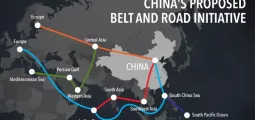Christopher Colford: Speed Bumps Along the Road to Competitiveness
Egypt’s Self-Inflicted Limits on Economic Efficiency.
It’s an axiom of economic policy: The future belongs to the efficient. In a relentlessly competitive global marketplace, those who manage to get just one step ahead of their rivals are destined to gain outsized rewards. Competitiveness requires policymakers to adopt efficiency-focused “rules of the road” that remove obstacles, accelerate innovation, mobilize capital, liberate ideas and speed goods to market.
That’s a universally accepted principle, right? I certainly thought so – until I hopped into a car in Egypt and began traveling the country’s highways.
Granted, we’re not talking about a rational environment here: This is more akin to a near-anarchy of motorised chaos. Egypt’s every-man-for-himself roadways are notorious for their mayhem. Traffic accidents, vehicle repairs and highway deaths reportedly reduce the country’s GDP by about 3% annually – an enormous drag on the competitiveness of a struggling economy that can ill afford any additional woes.

The old party headquarters (left) of ousted autocrat Hosni Mubarak, along the Nile River near Tahrir Square in Cairo. The buildings were looted and burned in January 2011 during the early stages of Egypt’s revolution.
So perhaps I should have been prepared for the highway bedlam that I experienced during my travels in Cairo and Giza last winter and during my explorations this spring around a broad swath of the Nile Delta region. You haven’t fully experienced traffic-jam frustration until you’ve endured the anarchy of Egypt’s roadways, where every vehicle known to humanity – from the humble donkey-cart to the most stylish limousine, from the most aggressive “tuk tuk” taxi to the most overladen multi-unit freighter – contends ruthlessly for every last centimetre of scarce road space.
Bumps in the Road
Yet the mind boggles at one of Egypt’s self-inflicted impediments to mobility and efficiency: the ubiquitous use, on roadways large and small, of the speed bump – smack-dab in the middle of major highways, forcing free-flowing traffic to come to a screeching halt.
Focusing on strengthening urban productivity – analysing economies through the lens of the “competitive cities” approach, which weighs the many factors that contribute to metropolitan-level dynamism – I’ve come to see Egypt’s use of the speed bump, even on what should be top-speed superhighways, as a metaphor for the country’s deeply troubled competitive position.
“Mercilessly effective in forcing traffic to slow down, unmarked speed bumps are built into Egypt’s highways at unpredictable intervals.”
Initially, I hesitated to write about the speed-bump factor – dreading that, as just an occasional visitor to Egypt, I might be overgeneralising, based on travels mostly on the Cairo region’s traffic-choked roads. But amid my most recent travels in additional regions, I continuously observed the same speed-bump phenomenon – around the Nile Delta city of Mansoura and then up toward Damietta, and around smaller towns like Talkha, Markaz Sherbin and Bilqas. The speed bump is clearly a widely used Egyptian traffic-management tool, inspiring wonderment and begging for further analysis.
Mercilessly effective in forcing traffic to slow down, unmarked speed bumps are built into Egypt’s highways at unpredictable intervals. They require drivers to be ever-vigilant, for fear of bottoming-out their cars and ruining their transmissions. Just to clarify: Egypt’s speed bumps are not like the modest, inches-high humps that decorously restrain drivers in suburban European or North American cul-de-sacs: We’re talking about major-league obstructions in the roadway.
On otherwise modern superhighways around places like Sheikh Zayed City and 6 October City in the Giza governorate – where urban planners are creating modern cities in the once-empty desert, hoping to relieve some of the pressure on overcrowded Cairo – traffic must come from mile-a-minute cruising speed to a near-standstill when drivers spot each tall, unpainted speed bump. On the narrower north-south highway paralleling the Nile River, where passenger cars must already contend with heavy trucks trundling to and from Mediterranean ports, drivers’ wariness of stealthy speed bumps is an added factor slowing traffic to an exasperating crawl.
The Pharaoh Within
![In a dusty desert town in Egypt, I happened to run across a local example of the practical impact of international assistance to developing countries. A prominent plaque on the courtyard wall of the Al-Saida Preparatory School in the town of Markaz Sherbin declares, “This school has been established in co-operation with [the] World Bank.”](https://cfi.co/wp-content/uploads/2014/07/cc3.jpg)
In a dusty desert town in Egypt, I happened to run across a local example of the practical impact of international assistance to developing countries. A prominent plaque on the courtyard wall of the Al-Saida Preparatory School in the town of Markaz Sherbin declares, “This school has been established in co-operation with [the] World Bank.”
Why the speed bumps – along major traffic arteries, no less? As Egyptian friends explained to me, most Egyptian drivers routinely ignore any posted speed limit – and, it seems, just about every other attempt at traffic regulation. “When we climb behind the wheel,” I was told, “we discover that there’s a little bit of a Pharaoh within all of us.”
In a desperate effort to reduce accidents and highway fatalities, the system of unpredictable, unmarked speed bumps can achieve what even a battalion of traffic cops could never accomplish: enforce slower speeds.
Insidious by day and invisible at night, the speed bumps are a potentially ingenious traffic-control tool – yet their side effects can inflict a jolting impact even on cars with skilful drivers. Woe to any car (like mine) that fails to anticipate a looming speed bump, even at moderate speed: The impact on a car’s suspension and transmission – and its passengers’ spines – can be shattering.
We accidentally took the full-on impact of a speed bump near the town of Mit Ghamr – wrenching our car’s front brakes out of alignment for the remainder of the week, and forcing us to wonder whether, in case of an emergency, the scraping-and-grinding brakes might fail.
Self-imposed speed bumps along the arteries of commerce, it strikes me, are a useful metaphor for what ails so many economies. Societies sometimes resort to deliberate and self-limiting policy interventions to bring some rationality to human behaviour in various civic pursuits – not just in regulating something as straightforward as traffic, but in restraining the most complex areas of the pell-mell modern economy. Since individuals cannot always be trusted to obey the agreed-upon social contract, societies often resort to imposing quasi-irrational speed bumps on behaviour – restraints that can, cumulatively, become a debilitating drain on efficiency.
Sub-optimal Restraints
We tolerate convoluted tax policies to try to socially redistribute some wealth, aiming to compensate for the tendency toward ever-greater inequality that – as Prof. Thomas Piketty of the Paris School of Economics has conclusively proven – is an inherent problem within modern-day capitalism. We condone a patchwork of narrowly targeted investment incentives, aiming for idealistic outcomes, yet often merely reward rent-seeking oligopolies and political cronies. We sometimes enforce hair-splitting antitrust standards to limit the threat of monopolistic abuses, yet we allow corporate incumbents to dominate vast and economically strategic industries. We enact full-disclosure regulations and anti-insider-trading safeguards to prevent dishonest dealing in securities markets, yet we wink at split-second trading platforms that give decisive advantages to hair-trigger traders armed with privileged data. We impose tariffs and quotas to protect uncompetitive local industries from more efficient international rivals, yet posturing free-market fundamentalists claim (especially in the United States) that we’d never even think of adopting any sort of strategic “industrial policy.”
Safeguards are vital, to be sure – but at what cost to efficiency and productivity? Such metaphorical speed bumps often succeed in slowing economic traffic, but they can also skew incentives, provoke resentful non-compliance and disrupt the “just-in-time” delivery of goods to market. Moreover, excessive restraints – especially those that reinforce the privileged status of entrenched incumbents – can interfere with the mobilisation of capital for far-sighted investment, impede the liberation of ideas for innovation, and undermine confidence in markets’ fairness.
In the relentless global economy – which champions efficient competitors and condemns low-productivity pursuits to oblivion – society’s speed bumps must be continually reconsidered and recalibrated. As nations’ competitiveness evolves, policymakers must continually re-think whether yesterday’s improvisations can effectively deliver tomorrow’s solutions. Familiar social-welfare mechanisms can sometimes become outdated; longstanding tariff barriers can outlive their usefulness; anachronistic provisions in the tax code can become counterproductive; chronic dependence on subsidies can distort markets more than promote inclusion.
Crying Out for Reform
For policymakers, some of the social speed bumps that we have imposed on our economic landscape cry out for reform; others may remain tolerable, despite the economic toll they inflict. That’s where public-spirited politics and good governance enter the picture.
The challenge is to get the balance right in today’s hyper-speed global marketplace that is ever-eager to exalt successful competitors and expunge economic laggards. Continuously adjusting those wise restraints that enhance social fairness, and recalibrating those tolerable trade-offs that promote shared prosperity, is a perpetual test of “the art of the possible.”
Coming back to the context of Egypt and its speed bumps, both literal and metaphorical: My hunch is that, just as Cairo’s motorists will have to continue to negotiate highway speed bumps long into the future, Egypt’s would-be job-creators and innovators will have to continue to confront their society’s built-in barriers – fiscal, regulatory, political, social and behavioural – that collectively impede the country’s economic performance.
Building city-focused competitiveness seems to be the most promising place to seek workable solutions to grand-scale economic challenges. For policymakers in Egypt, and in every country, strengthening competitiveness at the urban level may be the surest way to help make national economies more vibrant and productive.
The world’s emerging megacities are destined to be the engines of the global economy. Concentrating on building competitive cities offers insights that can help policymakers analyse policies that optimise productivity. The focus on urban competitiveness can also offer us new perspectives on the socioeconomic speed bumps that are bound to pop up, rationally or irrationally, along the road toward the destination that we’re all seeking: a world where we have, at last, eliminated extreme poverty and built shared prosperity.
About the Author

Christopher Colford is a speechwriter and editor at the World Bank in Washington, D.C. He was previously a consultant at Hill & Knowlton Public Affairs Worldwide and a senior editor at McKinsey & Company.
You may have an interest in also reading…
Ghana Get You: African Nation’s IT Experts are Filling the Skills Gap
Ostec is Ghana’s leading IT Infrastructure and managed services company, providing a single source of technology, skills and expertise to
UN Spotlights Key Role of Evaluation in New Development Agenda
Evaluation will become more necessary for the post-2015 Sustainable Development Goals, a United Nations body said today, as it launched
OECD: Time, Trade and Trade Facilitation
Time is money and a lot of money and opportunities are being lost due to painstakingly long customs procedures, waiting




























































































